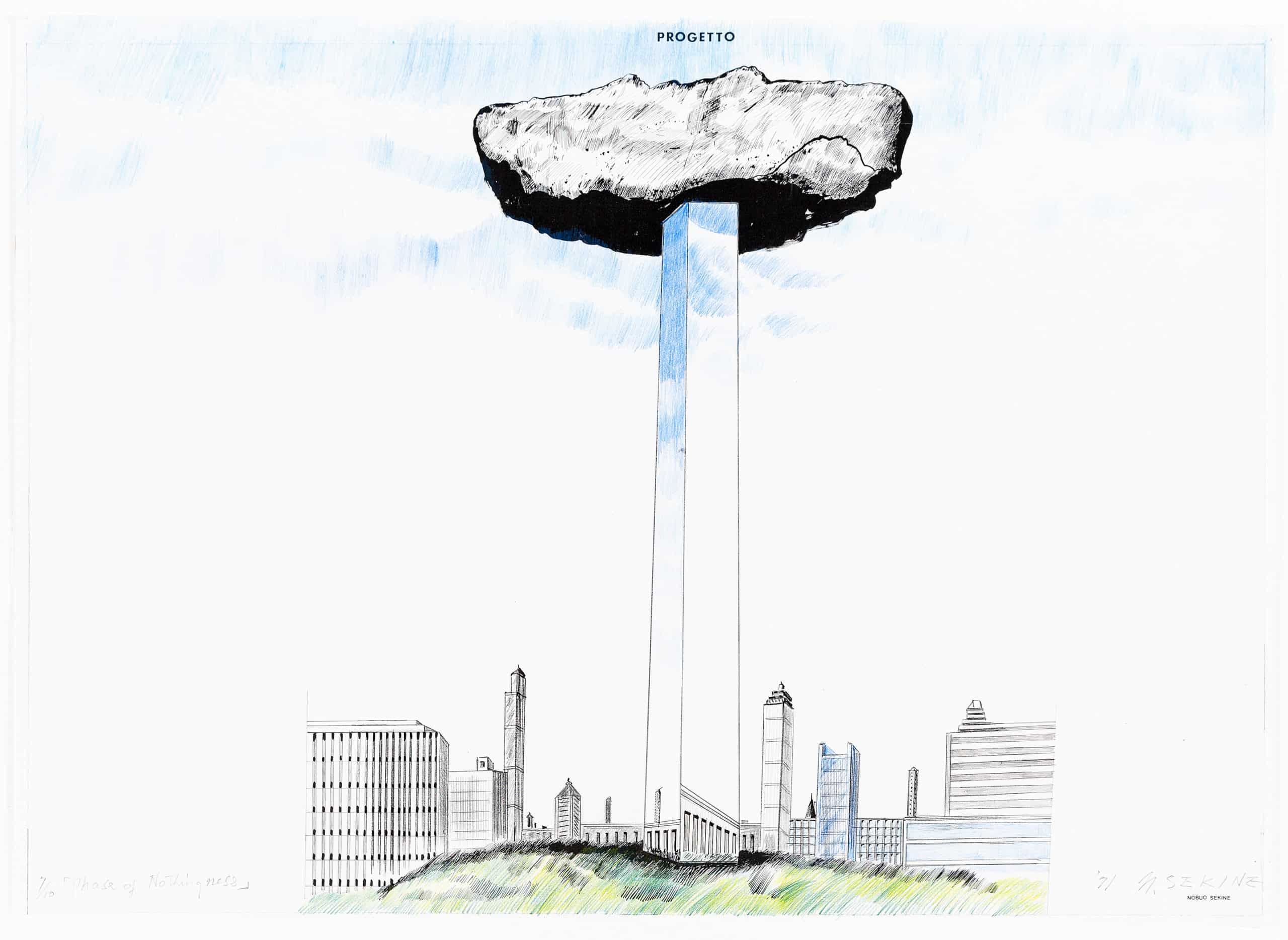Nobuo Sekine: The Weight of Things

‘A stone yearning for the sky.’[1] Such was the sort of rock Nobuo Sekine sought out at a quarry near Udine in the months prior to the opening of the 1970 Venice Biennale. A hulking, oblong piece of unfinished stone perched precariously upon a stainless-steel pillar, Sekine’s sculpture Phase of Nothingness towered above the heads of visitors approaching the Japanese Pavilion. The surface of the column was assiduously polished, reflecting both the bodies of attendees and the verdant surroundings of the Giardini. Camouflaging itself into its environs while distorting their image, the monolith’s oscillating state of visibility rendered the hefty stone into a cloudlike form, seemingly denying its obvious materiality.
In this sketch, the assemblage now unveils itself in a new landscape, amidst transformed circumstances and perceptual conditions. No longer situated within the lush promenades of the Biennale, a Phase of Nothingness now arises from the green earth, thrusting itself hundreds, maybe even thousands, of feet into the sky as it towers over an unidentifiable modern city skyline.
Sekine created the drawing during a two-year period of travel in Europe following the Biennale. The Phase of Nothingness staged in Venice was iterated from an earlier sculpture installed in Hakone in 1969, and this drawing in effect constitutes yet another iteration of the same piece. This sort of re-enactment was a common strategy for Sekine and the other artists of the Mono-ha movement, whose members took a keen interest in the states of ‘things’ and their existence in the world, attempting to free them from the objectifying tendencies of the human gaze while (contradictorily) rejecting the notion of art-making as a wilful act of creation.[2]
Mono-ha works were typically ephemeral, with importance placed not on the creation of a legible, preservable product but rather on the acts and encounters that arose from the artwork’s existence in a given space.[3] Using natural materials like cotton, soil, and stone, juxtaposed against industrial materials such as iron bars, steel plates, and glass panels, the assemblages constructed by the young artists, often at scales that eclipsed the human form, were absurd in their composition yet unflinching in their assertion of the material essence of things as they existed in the word, stripped of the burdens of signification.[4]
In retrospect, Sekine’s two-year European sojourn appears not merely symptomatic of a young artist hungry for inspiration and adventure, but rather almost a conscious effort to extract himself from a context that was becoming increasingly cacophonic. After the technopolitical spectacle of Expo ’70 (where Sekine restaged his seminal work Phase – Mother Earth), the suppression of the left after the renewal of the U.S.-Japan Security Treaty and the effective demise of the postwar avant-garde, coupled with explosive episodes like Yukio Mishima’s suicide and unrelenting economic and urban growth, ‘things’ may have been all that remained legible in the social rubble.
When he engages with drawing, Sekine is liberated from the labours of fabrication, the logistics of curation, and the engineering challenges that became part and parcel with the practice of Mono-ha artists. Drawing is at once an exercise of planning and dreaming, allowing Sekine to reimagine his contemporary dolmens as active matter across shifting scalar and environmental conditions. Indeed, the artist himself recalled encountering the initial image of a natural rock floating in the sky through a process of repeated sketching.[5] In this iteration, a new language of monumentality reveals itself, one that echoes the language of its surroundings—the reflective surface of the pillar linked to the glass building facades by way of hatched blue lines—while dissolving all the purity of form and marvels of engineering inherent in the cityscape through the simple act of placing a boulder atop a steel pillar. Through Sekine’s balancing acts, the Phases become monuments to the vivid reciprocity between ‘things’ and their environments, disappearing and reappearing across varied media to carry on a ceaseless dialogue.
Notes
- ‘Sekine Nobuo Oral History #2,’ Oral History Archives of Japanese Art, March 29, 2015 <https://oralarthistory.org/archives/interviews/sekine_nobuo_02/> [Accessed October 12, 2023].
- Mono-ha, both in their status as a group and in their collective philosophy, was rife with contradictions, as Reiko Tomii has elucidated. Their practice demanded visitors to deconstruct their habits of treating artworks as objects for optical consumption, while at the same time presenting their pieces within the institutionalized contexts that historically condoned the very ways of encountering art that the Mono-ha artists sought to reject. See Reiko Tomii, ‘Six Contradictions of Mono-ha,’ Review of Japanese Culture and Society, 25 (December 2013), 214-222.
- Mika Yoshitake, ‘Mono-ha: Living Structures,’ in Requiem for the Sun: The Art of Mono-ha, published on the occasion of the exhibition ‘Requiem for the Sun: The Art of Mono-ha,’ curated by Mika Yoshitake (Los Angeles: Blum & Poe, 2012), 102.
- Takehata Akira, ‘Mono-ha and Japan’s Crisis of the Modern,’ Third Text 16:3 (2002), 232.
- ‘Nobuo Sekine Interview: Sensibility of a Rock,’ Louisiana Museum, video, December 6, 2016, <https://www.youtube.com/watch?v=EPyucV8hUXc&t=190s> [accessed October 12, 2023].
Nanase Shirokawa is an arts worker and writer based in Cambridge, MA.
This text is one of the selected responses to the Open Call: Storytellers, Observed—an inquiry into the origin and circumstances of a single drawing (or series of drawings), observing the ways by which each achieves the specific purpose for which it was made. For further information click here.

– Aris Kafantaris